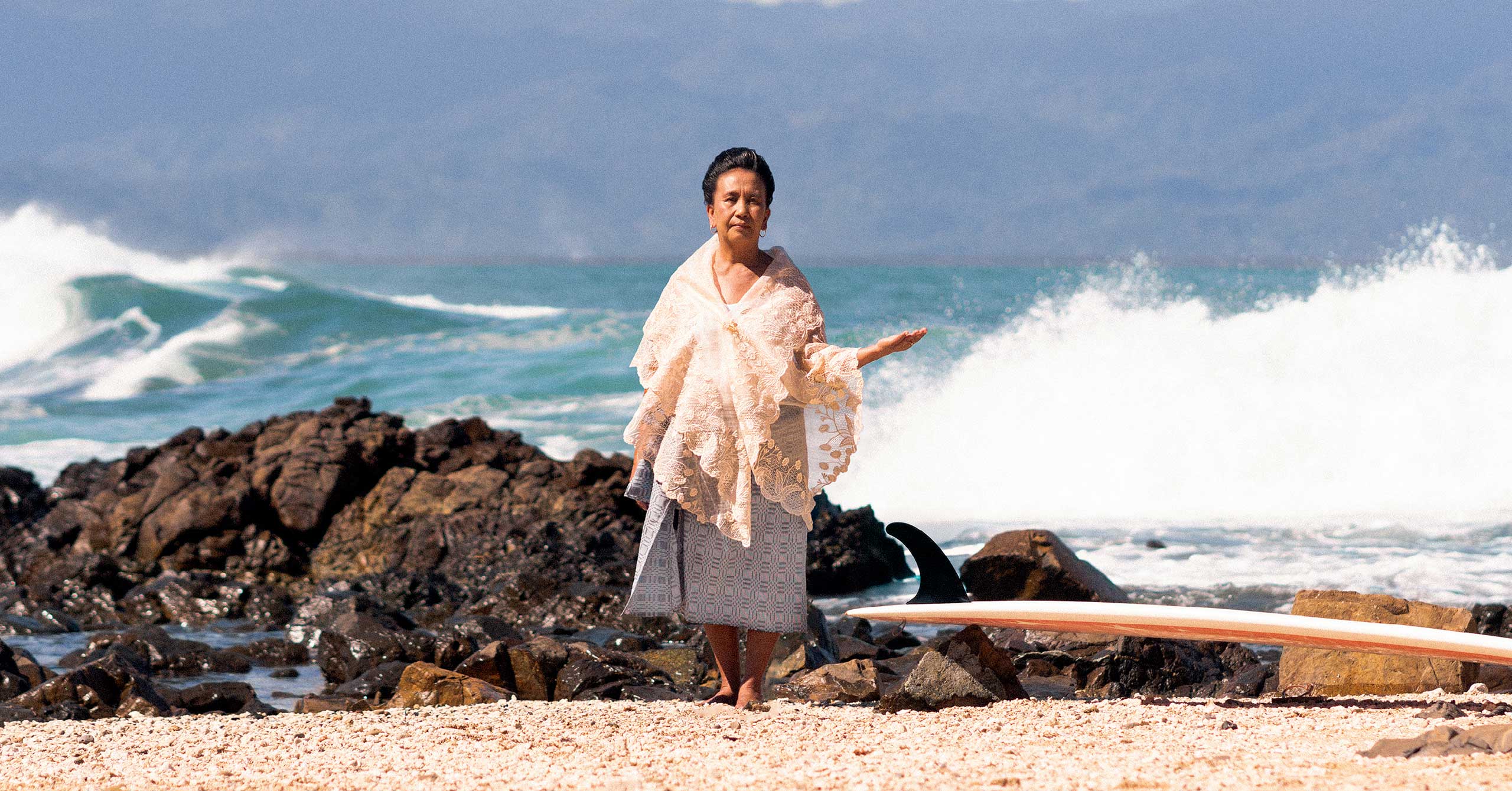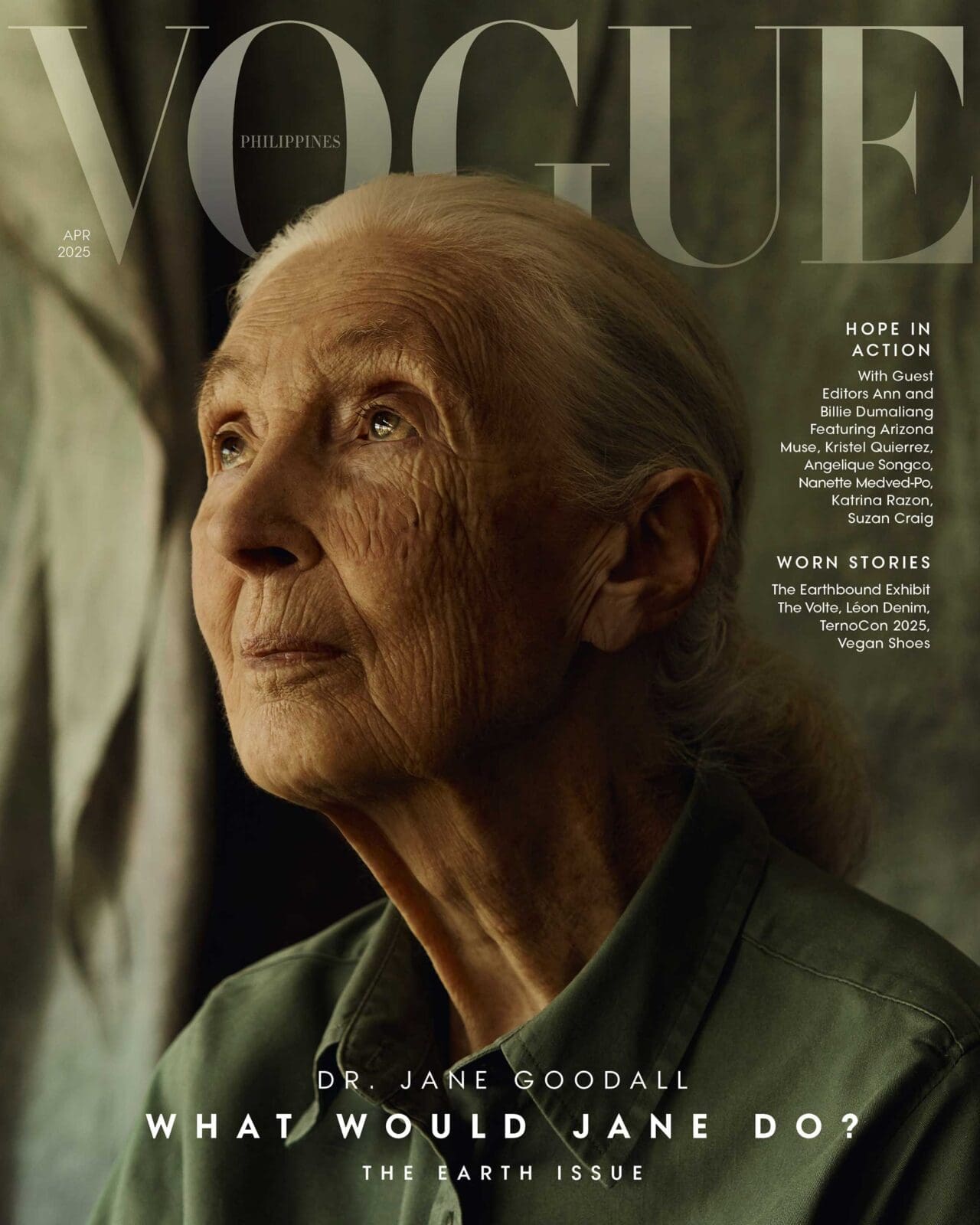Yvok wears a TESOROS top and YANA’S TEXTILE bottom. Photographed by Archie Geotina for the April 2025 Issue of Vogue Philippines
Yvok wears a TESOROS top and YANA’S TEXTILE bottom. Photographed by Archie Geotina for the April 2025 Issue of Vogue Philippines
Artist Archie Geotina continues his photographic series Pearls, featuring women surfers riding the waves in the intricate and textured layers of traditional Filipiniana dress, in Baler.
How a photograph of a 76-year-old Filipina woman and her granddaughter, a junior surf champ from Baler, ended up in the Maritime Museum of Barcelona has a back story that spans over a century. Lines that are traced through history run more like ocean currents that circle the globe, pulled and pushed by trade winds, carrying life across vast distances, and bridging together distant shores.
Baler, a coastal town on the eastern side of Luzon, is known in the story of the Philippine revolution as the site of Spain’s last stand in the archipelago. In 1898, Spanish troops had barricaded themselves in the church of Baler, refusing to believe that the war was over and that Spain had surrendered to the United States. The soldiers remained in the church, ignoring the newspapers that were left at their door, believing them to bear fake news. When the troops, finally convinced, emerged from the church after nearly a year, they were surprised to be welcomed with cheers and warmth by the Filipinos. The Spanish were treated as friends, not prisoners, and were granted safe passage home. The spirit of honor and resilience embodied in the Siege of Baler is today honored yearly during the Philippine-Spanish Friendship Day.

In 2023, Baler was officially recognized as the “Birthplace of Philippine Surfing” in a Republic Act authored by Sen. Sonny Angara. Lore has it that surfing was a child of Apocalypse Now. After the crew wrapped up filming in Baler in 1976, the locals picked up a couple of surfboards which had been left behind. But more nuanced accounts attribute its origins to an American teen named Steve Scott, whose family was stationed at Subic Bay Naval Base. Traveling around the country in 1972, he discovered the quiet fishing village of Baler had some great swells. According to Scott, it was also he who guided Ford Coppola’s film crew to Baler when they were scouting for a location to shoot surf and battle scenes, a spot by Sabang Beach which would eventually come to be known as Charlie’s Point. Returning to Baler in 1984, Scott saw kids sharing the surfboards he and the others had left behind, ostensibly witnessing the inception of Philippine surf culture.
Yvok “Inay” Namoro, one of the first female surfers from Baler, ventures out to the water only once or twice a year now, having directed her energies to mentoring her 13-year-old granddaughter Cathleya Namoro Casals. With the strict guidance of an elder, Inay is cultivating aspirations of her protégé’s future with the Philippine Team. She recalls her own early days: “I first started surfing in 1986, I was 22 years old. Back then, foreigners who traveled through the area would sell their boards to the locals when they ran out of money.” Rosalie “Ta Nene” Ritual, Gladys Villareal, and Yvok were the only competitive women surfers in Baler. “It’s too bad there weren’t any videos of us then,” she says. “But it delights me to see so many women surfing now.”


Inay, Cathleya, Ta Nene, along with a pregnant Marie Cabel make up the four subjects of artist Archie Geotina’s Baler edition of Pearls, an ongoing photographic series which he began in his adopted home of Siargao in 2021. Pearls celebrated the strength and beauty of women surfers, who rode the waves not in bikinis or sponsored gear, but wearing the intricate and textured layers of traditional Filipiniana dress. These images, shot in black and white, were visually and emotionally striking in how the women displayed defiance and joy as they danced on the sea unencumbered by the weight of what they wear, transforming restriction into freedom.
Gaining momentum through social media, Pearls emerged as a definitive cultural moment of this generation, much as Jake Verzosa’s The Last Tattooed Women of Kalinga did over a decade earlier, establishing itself as a globally recognized piece of Philippine iconography. After Siargao, the project spread to other seas, from Mexico to China, Indonesia, Thailand, and South Korea, where the surfer girls from each locale take to the waves in their national costume, a universal pageant of hanboks and hang tens, huipils over wetsuits.
“For me, Pearls has always been a collaborative endeavor.”
Much of the expansion almost didn’t happen. “I took a break from the project because I was already feeling like… you know how musicians have a great song and people just want to keep hearing that one song, and I’m like, I don’t want to play ‘Smells Like Teen Spirit’ all over again,” Geotina laughs.
But sustained, if not intensified interest in his work revitalized the vision of Pearls. “So many different countries are calling me to fly there. New Zealand messaged me recently, like the Maori people want their own [series], so it’s super cool,” he says. “It has a life of its own now. It’s kind of like my version of street art or public art. It’s a responsibility of mine now, which I’m pretty humbled by.”
To create an edition of Pearls, Geotina usually directs and photographs the lifestyle and land shots, while a local surf photographer captures the surf sequences. “I don’t shoot in the water, I would love to learn how, but it’s kind of an effort,” he admits. “So I hire a local photographer who I respect and whose work I love. For me, Pearls has always been a collaborative endeavor.” With Baler, he contacted Marie Cabel, a surfer who became both muse and behind-the-lens talent, all the while pregnant, repping the future generation.

The Baler iteration materialized through an invitation from the Philippine Consulate General in Barcelona and a partnership with the Department of Trade and Industry Philippines and Sen. Sonny Angara, a native son of Baler. Since Baler is the birthplace of Philippine surfing (“arguably,” interjects Geotina), as well as the progenitor of Philippine-Spanish Friendship Day, the collaboration was serendipitous. Earlier in March, the exhibit opened at the Maritime Museum in Barcelona to an audience of Spanish and diasporic Filipinos. Geotina nearly welled up at the sight of fellow Pinoys proudly taking a photograph with the studded terno outfit by Dennis Lustico and the tasseled terno gown by Rajo Laurel that the designers provided for the shoot, couture pieces that are now part of the exhibit.
It may be some time before Geotina himself can return to surfing—after Barcelona, he is off to do Pearls: Sri Lanka. Despite the pace, he’s been feeling inspired to create more. “Like I said, it has turned into a responsibility to the people who have fallen in love with the project, to keep continuing it. Even though sometimes I feel like a broken record, there’s always a twist and turn to the idea,” he says. “There are so many ways to make it new, and so many other cultures to share.”
By AUDREY CARPIO. Photographs by ARCHIE GEOTINA. Make Up & Hair by TISH MAHTANI OF ULO SALON. Surf Photographers: Marie Cabel, Joseph Mikala.

